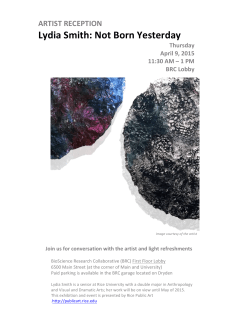
The Halpin PhD Studentship Programme Combating Rice Blast
The Halpin PhD Studentship Programme Combating Rice Blast Disease Professor Nicholas J. Talbot FRS The long-term aim of the Halpin PhD studentship programme is to train the next generation of molecular plant pathologists from developing countries in order to build local expertise that can be use to combat rice blast disease and serious agricultural threats to food security. Rice blast disease Rice is the staple crop for more than half of the World’s people and contributes 23% of the calories consumed by the current human population. According to the International Food Policy Research Institute, the rice harvest needs to increase by 38% by 2030 in order to meet the demands of the growing human population. Understanding and controlling the most important disease of cultivated rice is therefore of critical importance. Rice Blast Disease attacks a rice plant in the laboratory Rice blast disease represents a significant constraint on worldwide rice production. At present more than 629 million tonnes of rice are produced annually on around 150 million hectares of land, producing 410 million tonnes of milled rice per annum. While rice yields increased dramatically in the 1960s when new varieties became available through the green revolution, more recently there have been only modest increases in rice yield (only 1.2% between 2000 and 2006). Preventing disease losses from rice is therefore an important challenge and could play a very significant role in rice production. Rice blast disease causes losses of between 11% and 30% every year (up to 189 million tonnes in lost production) and this constitutes enough rice to feed 60 million people. Recent epidemics have occurred throughout the rice-producing regions of the World, including Kenya, India, Korea, Japan, and Colombia. In Kenya in 2008 a region of 5600 hectares of rice in the Central Province was completely destroyed, and 76% of farmers in Kenya were affected by the disease, typically suffering 60-100% yield losses. Meanwhile, in China, for example, a recent outbreak of rice blast caused losses of 5.7 million Ha of rice production between 2001 and 2005. The ascomycete fungus Magnaporthe oryzae, which is now widely studied, causes rice blast disease. The fungus is specially adapted to attack rice plants and produces a special infection structure, the appressorium, which it uses to puncture the rice leaf surface. The rice blast fungus gains entry to the leaf using physical force and enters the epidermis of the rice leaf, spreading throughout the leaf and causing disease symptoms within 3-4 days. The University of Exeter Rice Blast Research Programme Transmission electron micrograph of a penetration peg emerging from the base of a M. oryzae appressorium and rupturing the host cuticle. Rice blast research in the laboratory of Professor Nick Talbot has focused on investigating the biology of the rice blast fungus Magnaporthe oryzae using a wide range of genetic, genomic and cell biological approaches (for reviews, see Talbot, 2003 Annu Rev. Microbiol. 57: 177-202; Wilson and Talbot, 2009 Nature Reviews Microbiology 7: 185-195; Perez-Nadales et al., 2014: Fungal Genet. Biol. 70: 42-67). Rice blast disease is very tractable for experimental study because the fungus can be cultured easily and is readily manipulated by both classical and molecular genetics. Furthermore, the genome sequences of both the host and pathogen are now available, allowing genomic technologies, such as transcriptional profiling and proteomics, to be carried out. The Talbot laboratory has been particularly focused on studying appressorium-mediated plant infection in M. oryzae. Appressoria are dome-shaped unicellular infection structures that develop enormous turgor to cause physical breakage of the plant cuticle and entry by the pathogen. We demonstrated that the appressorium develops pressure by accumulating very large concentrations of glycerol, which draws water into the cell to create hydrostatic turgor (de Jong et al., 1997 Nature 389: 244-45) and subsequently showed that lipid and glycogen mobilisation, under control of the MAPK and cAMP response pathways, provide the precursors for glycerol synthesis (Dixon et al., 1999 Plant Cell 11: 2045-58 ; Thines et al., 2000 Plant Cell 12: 1703-18). We also demonstrated that the glyoxylate shunt (Wang et al., 2003 Molec. Microbiol. 47: 160112), peroxisomal fatty acid -oxidation (Bhambra et al., 2006 Molec. Microbiol. 61: 46- 60) and trehalose synthesis are required for appressorium function (Foster et al., 2003 EMBO J. 22: 225-35). This work showed that mutants lacking trehalose-6-phosphate synthase (Tps1), the key biosynthetic enzyme for trehalose, were unable to cause plant disease. Tps1 plays a pivotal role in integrating sugar signaling and nitrogen source utilization by the rice blast fungus. In addition to its enzymatic function, the Tps1 protein acts as a regulator of the pentose phosphate pathway and also acts at the transcriptional level to regulate genes involved in nitrogen source utilization (Wilson et al., 2007 EMBO J. 26: 3673-85). It is now clear that Tps1 directly binds to NADPH and, thereby, regulates a set of related transcriptional co-repressors, comprising three proteins, Nmr1, Nmr2, and Nmr3, which can each bind NADP. Tps1-dependent Nmr co-repressors control the expression of a set of virulence-associated genes that are de-repressed during appressorium-mediated plant infection (Wilson et al., 2010 Proc. Natl. Acad. Sci USA 107: 21902-21907). The laboratory also studied the role of morphogenetic proteins called hydrophobins in appressorium formation (Talbot et al., 1993 Plant Cell 5: 1575-90: Talbot et al., 1996 Plant Cell 8: 985-999) and characterized their function in cellular differentiation (Kershaw et al., 1998 EMBO J. 17: 3838-49; Talbot, 1999 Nature 398: 295-6; Kershaw et al., 2005 Molec. Microbiol. 56: 117-125). More recently, we discovered that appressorium morphogenesis is subject to cell cycle control and requires autophagic programmed cell death of the fungal spore and recycling of its contents to the developing appressorium (Veneault-Fourrey et al., 2006 Science 312: 580-3). Infection-associated autophagy was subsequently shown to be a nonselective macroautophagic process, based on a genome-wide functional assay in which 22 isogenic strains of the fungus were generated by targeted gene replacement, each differing by a single gene involved in autophagy (Kershaw & Talbot, (2009) Proc. Natl. Acad. Sci USA 106:15967-15972). Importantly, the study also showed that autophagic processes are controlled by cell cycle regulation and that a single round of mitosis shortly after spore germination is essential for appressoria to be formed. We now know that initiation of infection structure formation is controlled at S-phase, while maturation of appressoria is controlled by mitotic entry (Saunders et al., 2010 Plant Cell 22: 497-507), the first study to define the cell cycle control points necessary for plant infection by a pathogenic fungus. Mitosis and cytokinesis are spatially uncoupled during appressorium development and that spatial control of septation is pivotal to the development and functional competence of infection cells (Saunders et al., 2010 Plant Cell 22: 2417-2428). Most recently, we have investigated how appressorium turgor is applied as physical force and how cytoskeletal re-modeling is regulated within the appressorium to allow a penetration hypha to develop (Dagdas et al., 2012 Science 336:1590-95). We also showed that the Nox2 NADPH oxidase directly regulates septin recruitment to the appressorium pore and subsequent F-actin re-modelling (Ryder et al. 2013 Proc. Natl. Acad. Sci USA 110: 3179-84) to the point of plant infection. The laboratory has also identified virulence factors by forward genetics. A cyclophilin, for example, is necessary for appressorium turgor generation (Viaud et al., 2002 Plant Cell 14: 917-30) and we also demonstrated a novel role for metallothioneins in fungal cell wall differentiation during appressorium formation (Tucker et al., 2004 Plant Cell 16: 1575-88). A genetic screen to identify genes involved in plant tissue colonization led identification of a P-type ATPase of the aminophospholipid translocase family (Balhadère & Talbot, 2001 Plant Cell 13: 1987-2004) and allowed in the characterization of MgApt2, a P-type ATPase associated with the trans-Golgi network that is involved in fungal exocytosis during plant tissue invasion and is necessary both for pathogenicity and induction of host defence reactions in an incompatible response (Gilbert et al., 2006 Nature 440: 535-539). Most recently, we have explored effector function in rice blast and the suppression of chitin-triggered immunity in the host (Mentlak et al., 2012 Plant Cell 24: 322-335). Finally, the laboratory has a strong interest in fungal genome characterization and comparative fungal genomics and played a key role in the sequence annotation and interpretation of the M. oryzae genome sequence (Dean et al., 2005 Nature 434: 980986), the first genome sequence to be published from a plant pathogenic fungus. Comparative genome analysis has also provided new evolutionary insights, including the discovery that horizontal gene transfer has occurred between the filamentous fungi and a very distantly related group of non-photosynthetic filamentous eukaryotes called oomycetes. We have shown that gene exchange between these two morphologically similar species occurred long after their divergence from a common ancestor (Richards et al. 2006 Current Biology 16: 1857-64; Richards et al., 2011 Proc. Natl. Acad. Sci USA 108: 15258-15263). We have also used genomics to study pathogenic and saprotrophic fungi (Cornell et al., 2007 Genome Res. 17: 1809-1822; Soanes et al., 2008. PLoS ONE 3: e2300) and carry out transcriptional profile analysis during infection-related development (Soanes et al., 2012 PLoS Pathogens 8:e1002514). PhD projects will be selected from the range of ongoing research in the laboratory concerned with plant infection mechanisms, effector identification and recognition, plant tissue colonisation and disease symptom development. Research facilities The research group occupy state-of-the-art facilities at Exeter which opened in 2007 and are well equipped to carry out molecular genetics, genomics, cell biology and biochemistry research. The ACDP containment level 2 laboratory contains very modern equipment, robotic workstations, high quality analytical instruments and excellent facilities for plant growth. Rice cultivation under controlled conditions The rice blast research group is housed within the Geoffrey Pope Building, which has recently undergone a £25 million refurbishment. State-of-the-art facilities for molecular genetics, including automated DNA sequencing equipment and robotic workstations for high throughput DNA extraction, colony picking, and quantitative RT-PCR are available. Analytical instrumentation includes 400 MHz and 300 MHz NMR spectrometers, four mass spectrometers (LC-MS, Q-ToF-MS-MS, GC-Tof-MS), atomic absorption, FPLC/HPLC and elemental analysis. The Henry Wellcome Centre for Biocatalysis, which opened in 2003, houses X-ray crystallography, computer modelling and structural analysis equipment. A new Bio-Imaging Centre was opened in 2007 with a Zeiss Laser Confocal Microscope, Olympus/Visitron Laser Excitation Epifluorescence Microscope, Jeol Cryo-Scanning Electron Microscope, a Jeol 1400 Transmission Electron Microscope with tomographic capabilities, plunge-freeze, freeze substitution chambers, ultramicrotomes, and a wide range of epifluorescence microscopes. A dedicated Laser Excitation Epifluorescence Olympus microscopy workstation is also present in the main laboratory. Bioinformatics infrastructure includes 30 networked high specification linux PCs, Sun Workstations and a dedicated multi-node high capacity server. Biosciences also has an Illumina HiSeq2000 next generation DNA sequencer, to provide the latest instrumentation for genomic analysis. The Halpin PhD Studentship Programme The Halpin PhD Studentship programme will fund international students to train in rice blast research at the University of Exeter using the very latest procedures in molecular biology and genomics and receiving the very best intellectual and practical education concerning this important disease. Furthermore, they will receive a 4 year studentship with a generous stipend (~£19,000 per annum in the first instance), which is greater than standard PhD students, reflecting the personal investment being made by the student in seeking to train in a foreign country, and the highly prestigious and selective nature of these awards. The student will also receive a generous international travel grant and training awards. Please note that this programme is only available to students from outside of the EU. Halpin scholars will be trained in the latest procedures in molecular plant pathology, molecular genetics and genomics Applying to the Halpin PhD Studentship Programme Students from rice-growing regions of the world are actively encouraged to apply to this programme. Applicants can be from any nation in which rice cultivation plays an important role in food security and economic development. Applicants should have an excellent first degree in Biological Sciences, Molecular Biology, Biochemistry, Genetics, Plant Biology, or Plant Pathology and/or a relevant Masters degree qualification. Applicants should also submit details of their scores in relevant international qualifications/examinations that they may hold, such as the Graduate Record Examination (GRE). All entrants to the programme must have proficiency in English language skills (IELTS of greater than 6.0 or equivalent). For full details see http://www.exeter.ac.uk/postgraduate/apply/english/ Entry to the programme will be highly competitive and based on academic qualifications and demonstration of an aptitude and strong ambition for postgraduate research. Application procedures: Click here to apply You will need to submit some personal details, including the names and contact details of two referees, and upload the following documents (preferred format for uploaded files is .pdf and preferred filename should start with your last name): • • • • A full Curriculum Vitae (CV/Resume) with details of academic qualifications, skills and experience A two-page statement of why you are applying to the Halpin Studentship Programme and how you would use this opportunity to further a career in rice blast research Transcript(s) giving full details of subjects studied and grades/marks obtained (this should be an interim transcript if you are still studying) Evidence of English language ability eg, IELTS certificate If you have any general enquiries about the application process please email cles-studentships@exeter.ac.uk or phone +44 (0)1392 725150/723706/723310. The closing date for applications is midnight on Sunday 19th April 2015. Short-listed applicants will be contacted individually by e-mail with further details.
© Copyright 2025









